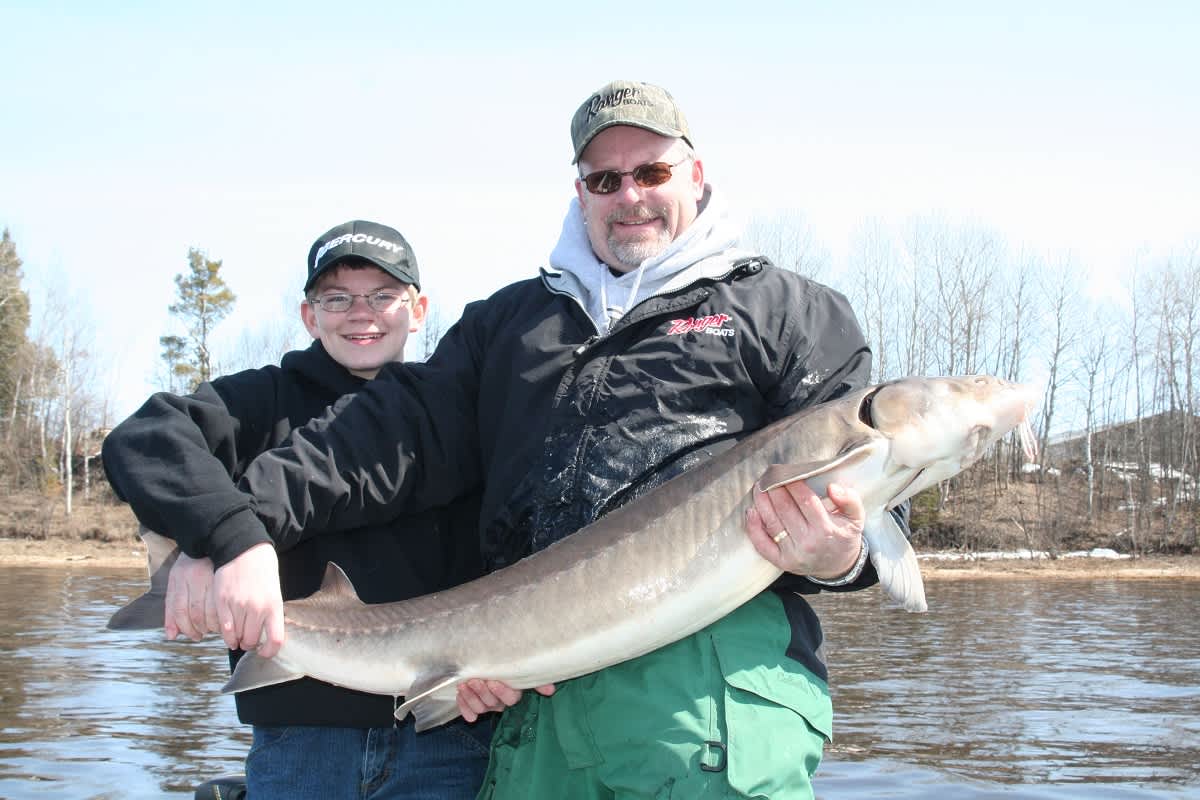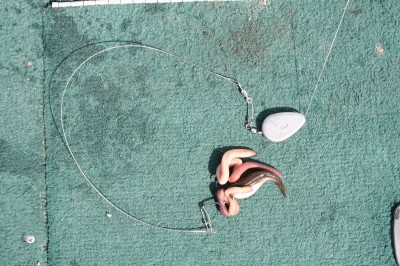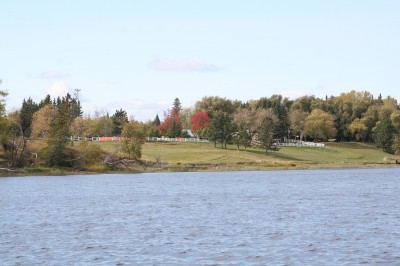Dinosaur Fishing: Finding and Catching Rainy River Sturgeon
Bernie Barringer 03.25.14

Giant fish cruise this northern Minnesota river in the spring and fall. It’s possibly the best place in North America to catch the biggest freshwater fish of your life.
There seems to come a point in any angler’s life when they would like to catch a really big fish. We all go through stages in our fishing. For most of us, we started out trying to catch a fish—any fish. Then we progress to the stage of trying to catch lots of fish. From there, most people move on to the stage where they focus on one or two species and try to catch outstanding specimens of that species.
I don’t want to short-circuit your progress through the stages of fishing, but I know of a place you can catch really big fish—and on a good day, you will catch a lot of them. To add to that, anyone can do it. The very young will tire quickly of trying to pull a 40-pounder off the bottom, but anyone with a little desire to do something out of the ordinary, and exercise their shoulder muscles in the process, will love this opportunity.
The Rainy River along the Minnesota-Ontario border is a unique place. The river spills into sprawling Lake of the Woods, one of the largest freshwater natural lakes in North America. The lake is home to the mighty lake sturgeon, but because the lake is so big, they are rarely caught. That gives them the time to grow big. They are vulnerable to angling twice a year: the early spring and the late fall. That’s when they move up the Rainy River.
As soon as the ice goes off the boat ramps along the side of the Rainy, anglers begin sliding their boats in to capitalize on the run of sturgeon and walleyes that pour into the river.

Sturgeon are a slow-growing fish, and this is, for all practical purposes, a catch and release fishing opportunity. Take your camera and some heavy tackle and just go enjoy the fun of it.
These sturgeon come in all sizes. We have caught them from 16 inches to 60 inches, but the majority will be between 40 and 50 inches. Most trips give us a chance at a 60, and we usually have at least a couple in the mid-50s. Those 60-inch fish are as old as most of us fishing for them, so we handle them with care and put them back to fight another day.
A 60-incher will weigh between 40 and 50 pounds. That’s a lot of fish to haul up off the bottom of the river, and these fish know how to use the current to their advantage. You’ll want heavy action rods with at least 40-pound line and a reel with a good drag cranked about as tight as you can get it. Our family likes to chase muskies, and this trip is a good opportunity to put our muskie tackle to off-season use. We primarily use 60-pound braided line on Abu Garcia 6500 or Revo Toro reels and heavy-action muskie rods. We’ve caught sturgeon while jigging for walleyes, but it takes a long time to get one landed, and the chances of breaking it off are better than not. If you are serious about catching these fish, don’t bring a knife to a gunfight—bring the right tackle for the job.
The bait part of this equation couldn’t be easier: use nightcrawlers and minnows. But things get a bit tricky with the border waters. There is an imaginary line down the middle of the river, and if you have live minnows in your boat, you must have a receipt that proves you bought them in Canada. That’s a problem that is easily solved. Buy your minnows in the United States, then if you decide to cross over the line into Ontario, simply dump a can of diet pop into your minnow bucket. You’ll have dead minnows in no time, and no problem with the Canadian wildlife authorities. The fish do not care if the minnows are dead, but they do seem to prefer them fresh.
We found it is best to put two to three minnows on the hook along with one or two nightcrawlers. This is all gobbed onto a 5/0 circle hook and held to the bottom with a three-ounce flat, no-roll sinker. Your line is threaded through the sinker so the fish can take line without feeling the weight. Cast out downstream and set your rod in the holder or lean it in the corner of the boat. All you do now is watch for the line to go tight or start moving across the current. It’s like fishing for 40-pound bullheads.
Sometimes you will see the rod tip start to bow down a little and that means you have a sturgeon on the line. Pick up the rod and make sure the slack is out of the line. There’s no need for a homerun style hook set, just reel down until you feel the fish and then sweep the rod upward in a long easy stroke. Let the circle hook do its job; the sturgeon’s mouth is fleshy and you don’t need a bone-jarring hookset.

Occasionally you will see the rod tip just wiggle or bounce a little. That’s usually a walleye picking up the meal. The same sweep-set will hook the majority of the walleyes, too. Walleyes have a reputation as finicky eaters, but it always amazes me how many we catch on that gob of dead minnows and crawlers.
If this all sounds easy, that’s because it is. The hardest part is finding the right spot to anchor up, and that is not too difficult—just a little time-consuming the first time out. The sturgeon relate to the deepest holes in the river. Most of them will be found from 16 to 22 feet deep, depending on the water level in any given year. Some of the holes are fairly long runs, maybe 100 yards or more. But it seems like the most active sturgeon are at the upstream end of the hole. Plus, if you anchor at the upstream end of the hole, your juicy offering is leaving a scent trail downstream. Sturgeon are very efficient at homing in and finding that free meal.
Use your depthfinder to learn the hole, and then position your boat right at the front end of it. Take your time and figure it out. It’s better to spend 15 minutes going over the spot watching the depthfinder than 30 minutes without a fish while you wonder if your boat is right on target. If you don’t catch a fish in 30 to 45 minutes, move on to the next hole. If you catch a fish, hit a waypoint on your GPS so you can come back and anchor in the exact spot again later.
You will want to anchor your boat across the current with two large anchors, one in the front and one in the back. Here’s how to do it. Go 30 feet or so to one side of where you want the boat to be sitting and drop an anchor. Then go back to 30 feet on the other side of where you want the boat and drop the other. You want to make a “V” shape with the boat at the point of the “V.” The boat will settle in where you want to be, and if the anchors are farther apart than the length of your boat, the boat will not swing in the current and pull your baits off-target.
Once you’re anchored, just cast out downstream, trying to keep the baits as far apart as possible. They will swing somewhat to the middle. But you can keep four baits working from the side of an average-sized fishing boat. When one line has a fish, get the others in right away. Big fish will go all over the place, and you do not want a tangled mess of lines. With heavy tackle, you can crank the drag down tight and wrestle the fish to the boat. One time we had a triple on these powerful fighters, all three of which were over 40 inches. That’s when it pays to be able to horse them in!
Just about everyone I know has a hankering to catch a really big fish. I can’t think of a place in the Midwest where you truly have an opportunity to catch a real monster on a very affordable trip. I would caution you that this can be a bit addicting! My family has made this trip an annual event, and I don’t see that ending any time soon.
Follow Bernie’s bowhunting adventures on his blog, bowhuntingroad.com.

